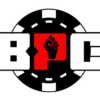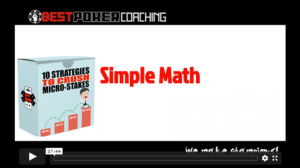It can be tough to know who to trust. Large amounts of conflicting strategy advice leave the average poker player confused. Naturally, we might turn to coaches, training videos and books for clarification, but when these also present heavily conflicting advice, it’s really easy to lose all sense of direction.
The truth is out there if we look deeply enough, but certain myths regarding the game of poker have been heavily propagated over the years. Even coaches and authors get sucked along with the hype and complicate the issue by promoting erroneous tactical ideas to their students.
This post is dedicated to correcting some of the worst poker advice you’ve ever heard.
“Always Cbet Dry Boards”
“It’s a King-high rainbow! Cbet everything!”
This one has been around for years. Perhaps your coach is actively teaching you to do this. Then again, one reason why certain myths have a tendency to stick is because they have a grounding in truth. It’s really easy to explain why this could potentially be sound strategy advice.
The myth finds its origins in the fact that the population folds frequently to cbets on A-high and K-high dry boards. Betting these boards with any two-cards allows us to generate automatic-profit. Many player-pools may be folding as much as 50% on A-high and K-high dry textures. The break-even point on a 2/3rds pot-sized cbet is 40%, so any folding frequency above this allows us to profitably bet any 2-cards.
Then again, the population is also folding around 43% to cbets in general across all board textures. This means that an any-2-cards cbet in the majority of spots generates automatic profit!
So, in that case, why do we not just cbet with 100% frequency on all board textures?
Because doing so would assume that we should always bet if betting generates a positive expectation. Elite players understand that this is not how poker works. We are interested in finding the line with the maximum expectation, not just any line that happens to generate profit. The decision to c-bet or not should depend on whether c-betting has a higher expectation than checking, not on whether c-betting has a positive expectation in a vacuum!
It’s possible to demonstrate that garbage holdings often have a higher expectation as delayed cbets as opposed to direct cbets. Sure, we don’t always get the opportunity to fire that delayed cbet depending on villain’s actions, but this is not necessarily a bad thing. We give villain an additional opportunity to define the strength of his range before we over-extend ourselves with garbage. C-betting garbage is hence rarely correct (apart from exploits that involve a strong read).
But what about those K-high and A-high draws where the population is folding at a rather lucrative looking frequency? It might seem at first glance as if we should make an exception here since the expectation of c-betting is higher than it would be compared to c-betting a random board texture. Again, we should take care to avoid the trap of analyzing the profitability of a line in a vacuum. Would it be surprising to learn that the population also folds significantly more often to delayed cbets on these textures? The fact that our direct c-bet works more frequently says nothing about the relative expectation of betting vs checking. It simply tells us that we can expect certain board textures to be more profitable for us as the aggressor. (Note that we also get more delayed cbet opportunities on Ace-high and King-high textures because the player pool float-bets and probe-bets less frequently.)
The basic way to correct this bad piece of advice is to avoid betting 100% or our range arbitrarily in certain spots. Just because the line might be profitable, doesn’t mean that it’s the best line. We are solely interested in max-EV lines. Very often the best default exploitative approach will involve betting with hands that have potential while using garbage holdings as delayed c-bets.
It’s hard to be a poker player for any length of time without hearing this one. The sad news is that a large percentage of poker players still actually believe this myth. This myth is especially problematic because it also encompasses the idea that we should only be using one bet-sizing in each spot (more on this later).
So how can we demonstrate that the idea is a myth? First of all, note that it’s not especially difficult to contrive a scenario where betting small likely makes sense on a drawy texture.
Imagine we open-raise preflop with KcTc and hit the following flop after the BB calls preflop and checks to us:
Ts9s7h
Application of the above myth would suggest that we should be betting large here. There are some serious issues with using big sizings here. However, while we potentially have the best hand, we can’t ignore the possibility that our opponent may have flopped a set, straight, or two-pair. Using large bet sizings increases the amount we lose when behind. At the same time, it also makes it less likely that our opponent calls with worse holdings. It’s not smart poker – a bet sizing of around 40-50% of the pot can reasonably be expected to generate an expectation close to the maximum.
The myth didn’t appear out of thin air, however, like other myths, it has a grounding in reality. Let’s take the same flop texture and imagine we now hold the Jd8d (nut straight). Betting big now clearly makes a lot of sense. We don’t need to fear isolating ourselves against better holdings (aside from rare freerolls), and there are plenty of worse hands that our opponent can pay off large big bets with. Betting small would be a waste, since it doesn’t extract the value and afford the protection that such a strong (but vulnerable) holding deserves.
The lesson we should extract from this is not that all hands should bet big on this flop texture but rather than a range of different bet-sizings likely make sense. This applies to semi-bluffs as well as value-hands. Some semi-bluffs may function better as part of a large bet-sizing range while others will function better as part of a small bet-sizing range. Examples include 4s5s playing well as part of a small bet-sizing range (or even a check), while As5s or QhJh plays well as part of a large bet-sizing range. We don’t need to be dogmatic about which hands belong precisely in which bet-sizing ranges, simply that a range of different bet-sizings often maximizes expectation in the majority of spots. Many players have a mental block in this area resulting from misconceptions regarding balance.
The inverse scenario could occur when flopping a set on a dry texture. The dry texture does not automatically guarantee that the hand should be used as part of a small bet-sizing range. This could especially be the case if our opponent turns out to be a calling station. Betting close to the pot-size (or even overbetting) could easily generate the highest expectation. It’s therefore recommended to avoid sweeping generalizations regarding bet-sizing and size each holding according to its own merits.

“Always bet the same sizing in each spot! If you don’t, villain will exploit you!”
Upon reaching the other side of the tunnel it’s easy to realize how idiotic this statement is. Some of us are still working on it, so let’s break it down in more depth. This myth is typically resultant from misconceptions regarding balance. It permeates heavily throughout various training resources. How can we debunk it?
Let’s do a quick thought experiment. Imagine a scenario where we bet weaker hands for a small sizing and stronger hands for a big sizing. Is there a problem here?
Many would assume there is. They would also assume that the way to fix the problem is to simply bet all hands for the same sizing. This demonstrates a grave misunderstanding of how balance works and can result in significant loss of EV. Keep in mind the following:
- Just because every hand in a range bets the same sizing does not mean that the range is balanced (it is still potentially open to exploitation).
2. Even if a range is somehow balanced in the purest sense, we still have to tackle the issues of whether balancing results in the highest expectation. (In nearly all cases it won’t).
- Use of multiple bet-sizings doesn’t necessarily imply imbalance. In fact, it’s virtually impossible to find equilibrium (balanced) solutions to poker hands without resorting to usage of a decent amount of different bet-sizings.
Let’s focus on the second point however, since this is by far the most relevant. To recap, we are betting small with our weaker hands and big with our stronger hands. Despite what some might think, this will typically constitute a strong exploitative approach, especially if we can make the assumption that our opponent won’t attempt to form a relevant counter-strategy. We get more chips in when we are strong, and limit the size of the pot when we are weaker. By arbitrarily attempting to “balance” our strategy without our opponent showing the propensity to adjust, we are essentially lowering our EV for no good reason.
Even still, many players are concerned that if they follow such an approach that villain will start exploiting their small bet-sizing range with aggressive raises. Even if this were to happen, is the solution to balance though? Not at all, the solution is to counter-exploit. We’d start betting all of our strong hands as part of the small bet-sizing range and our weaker hands as part of the large bet-sizing range. Decent players always go for the max-exploit line in every scenario. Arbitrarily using the same sizing with every hand in our betting range to avoid being exploited can significantly damage our expectation. It takes novice players a while to get to grips with this one. The paranoia that villain is sensing meaning behind their every bet sizing can easily result in consistent strategic blunders.
Dealing with Bad Advice
We’d all love to get straight-forward, accurate advice about the game. This is simply unrealistic in the current climate however, and we are all going to receive conflicting advice at some point in our career.
How do we resolve these conflicts? Naturally we can dig a little deeper regarding the credibility of our sources, but the truth is that bad advice can originate even from well-respected players. Ultimately, we ourselves have to be the tie-breaking entity. After all, we are the ones who are going to suffer if our bankroll takes a big hit while we operate on misleading advice. It’s down to us to weigh up all advice we are given and decide whether we are willing to trust it or not. Even when well respected professional is giving us advice, we should never lose the ability to question things as poker players. Do we agree that this is legit advice? Or is it just another poker myth?






